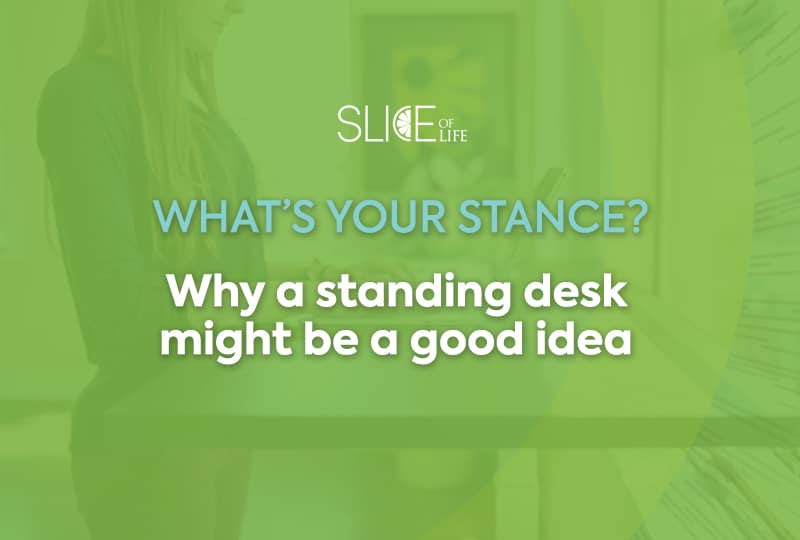It seems like every time you turn around these days, someone is trying to sell you some fancy gadget that will somehow magically transform your health. That said, there is a relatively new product that has begun to be featured in many offices that might live up to some of the hype: Standing desks. Healthline spells out its usefulness in their article, “7 benefits of a standing desk.”
The Center for Disease Control (CDC) reports that over 60 percent of U.S. adults don’t engage in the recommended amount of activity, and roughly 25 percent of U.S. adults aren’t physically active at all. Sitting for too long on a regular basis increases the risk of numerous health problems, such as diabetes, heart disease, weight gain and obesity. So, if you work in an office, how do you combat the bad effects of too much sitting? Standing desks have been a big help for many people in this regard.
Standing desks are designed to help you stand up comfortably while working. Many of the versions on the market are adjustable, so you can alter the height as needed and alternate between sitting and standing. Research is still early on standing desks and sit-stand desks, but so far it appears that the use of a standing desk is an asset to health and possibly even productivity as well. At least it is a start in the right direction to partially negate the hurtful effects of sitting too much.
Let’s look at the specific ways that a standing desk can be beneficial:
- Standing can help prevent weight and obesity. As we know, weight gain is caused by taking in more calories than what is burned off. And generally, weight loss stems from burning more calories than what is consumed. Exercise is the most effective way to quickly burn calories, but choosing to stand instead of sitting can also be a good plan. According to a study conducted by the Journal of Occupational and Environmental Medicine, standing for an afternoon of work compared to the same amount of time sitting has been recorded to burn over 170 extra calories, almost 1,000 extra calories burned each week.
- For those looking to lower blood sugar levels, a standing desk might be a good decision to implement. Blood sugar levels increase after meals, and it can be dangerous when they rise to excessively high levels, especially for those who are insulin resistant or with type 2 diabetes. There have been studies that show promising results for office workers who stood for an hour or more after lunch, significantly reducing sugar spikes. Yet for those that find alternating between standing and sitting to be more manageable, there was a study that showed 23 office workers alternating every 30 minutes between sitting and standing throughout the workday reducing their blood sugar spikes by about 11 percent on average.
- If you are worried about heart health, it is best to increase your amount of time standing. Scientists have determined that sitting for prolonged periods poses a significant heart disease risk, at an increased likelihood of 147 percent, according to Diabetologia’s study and related studies.
- The effects of prolonged sedentary states are profound enough that even an hour of intense exercise might not help offset the harmful nature of a full day seated.
- Back pain is a relentless problem for many office workers, but standing desks can help reduce it. Several studies and programs promoting more standing in the workplace have shown that using standing desks over a short period of time will typically start to yield improvement in lower back pain by almost a third. Conversely, those that went back to a standard sitting desk noted that some of these improvements dissipated within two weeks of not using a sit-stand desk.
- Working long days seated in your chair can make you feel sluggish and stressed, but standing desks have appeared to have a positive influence on the general well-being of users.
- The 2011 Take-A-Stand project proved instrumental in helping us understand the immense value of standing desks. Preventing Chronic Disease (PCD) chronicled the comprehensive study, in which 87 percent of those using standing desks reported increased vigor and energy as they went about their days. These participants also noted that their moods returned to the base level that they were before when they went back to their old desks. A sedentary lifestyle has often been linked to an increased risk for anxiety and depression, so it might be time for you to take your own stand with a standing desk.
- Standing desks may take some getting used to, but their mood improvement capabilities could have a positive productivity impact.
There are best practices for using a standing desk to keep in mind, such as how long to use it for, the proper alignment of desk and screen, using an anti-fatigue mat and more. Visit this link for a full run-down of how to get the most out of a standing desk.
Slice of LIFE is an invitation to and extension of everything happening at Life University. Whether you are a current student, a potential freshman or a proud alumni, Slice of LIFE can help keep you connected to your academic community. Know of a compelling Life U story to be shared, such as a riveting project, innovative group or something similar? Let us know by emailing Marketing@life.edu.


Social Media